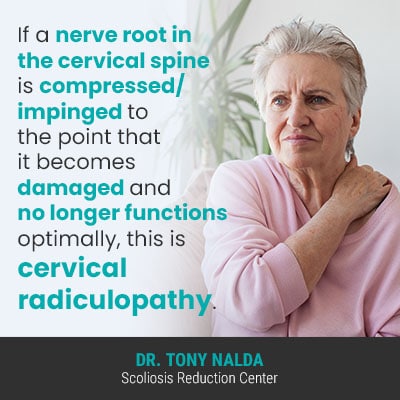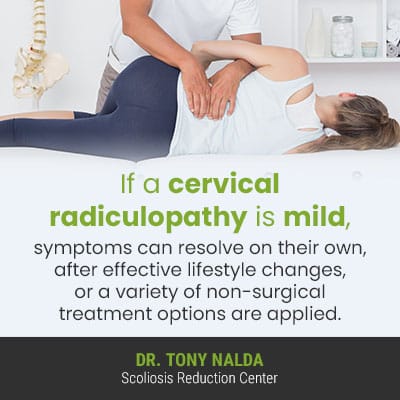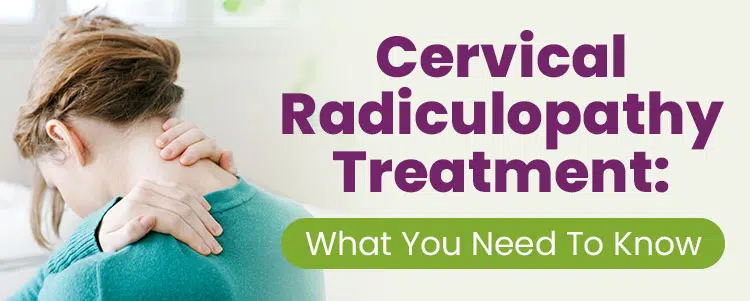A healthy spine consists of rectangular-shaped vertebrae (bones) stacked on top of one another in a straight and neutral alignment. The cervical spine contains 7 vertebrae that start at the base of the skull. Also known as a pinched nerve, when a nerve root’s function in the neck is impaired and is causing symptoms, this is diagnosed as cervical radiculopathy.
Cervical radiculopathy involves a compressed nerve root(s) in the cervical spine (neck); when a nerve root faces impingement/compression, it can become irritated and disrupt its neurological function. Cervical radiculopathy treatment will be case-specific and driven by its underlying cause.
For a better understanding of how the spinal nerves function and affect the body, let’s explore some basic spinal anatomy.
Spinal Anatomy and The Cervical Spine
As mentioned, in a healthy spine, the vertebrae are stacked on top of one another and separated by intervertebral discs.
The spinal discs help provide cushioning between adjacent vertebrae to prevent spinal degeneration, facilitate flexible movement, and act as the spine’s shock absorbers so mechanical stress is evenly absorbed/distributed.
The vertebrae and discs work together to maintain the spine’s natural curvatures and alignment; if the spine remains aligned and maintains its healthy curves, there is plenty of room for the spinal nerves to function optimally, but if a spinal nerve faces compression/impingement, its natural function is disrupted.
There are three main spinal sections: lumbar (lower back), thoracic (middle/upper back), and cervical (neck).
Not only does a healthy spine allow us to stand upright and provides the body with structure, it facilitates flexible movement and works in tandem with the brain to form the central nervous system (CNS); spinal conditions, such as a pinched nerve in the cervical spine, can cause a variety of symptoms felt throughout the body caused by disruptions in brain-body communication.
The Cervical Spine
Each spinal section has its own curvature type and natural curvature-degree range.
The cervical spine is home to the first 7 vertebrae that start at the base of the skull. The cervical vertebrae are important, and face stress, as the neck has to support the weight of the head.
In fact, the C5 and C6 vertebrae are commonly referred to as stress vertebrae because they bear the brunt of the neck and head’s weight. Upper extremity pain is a common symptom associated with issues in the cervical spine.
There are openings in the vertebrae called foramen, and the spinal nerve roots branch out through these openings to send/receive signals throughout the body.
When it comes to how nerves function, they are like limbs on a tree, branching off in multiple directions, which is why radicular pain can be felt throughout the body and far from the original site of nerve compression.

If a nerve root in the cervical spine is compressed/impinged to the point that it becomes damaged and no longer functions optimally, this is cervical radiculopathy.
Understanding Cervical Radiculopathy
Definition and Causes
Cervical radiculopathy is a condition that occurs when a nerve in the cervical spine is compressed or irritated, leading to pain, numbness, and weakness in the neck and arm. The cervical spine, composed of seven vertebrae starting at the base of the skull, houses nerves that branch out from the spinal cord through openings in the vertebrae. These nerves can become compressed or irritated due to several factors, including degenerative changes, herniated disks, bone spurs, and cervical spondylosis.
Degenerative changes in the cervical spine can cause the disks to wear down, reducing the space between the vertebrae and putting pressure on the nerves. Herniated disks, where the inner nucleus pushes through the outer annulus, can also compress the nerves, leading to pain and numbness in the arm. Bone spurs, which are abnormal bone growths, can similarly compress the nerves and cause symptoms of cervical radiculopathy. Cervical spondylosis, characterized by the wear and tear of the cervical spine, can also lead to nerve compression and the associated symptoms.
Cervical Radiculopathy
A variety of spinal issues/conditions introduce adverse spinal tension and uneven forces to the spine/body, and these uneven forces also affect the spine’s surroundings: tendons, muscles, and nerves.
When a nerve root experiences uneven pressure/compression, it can become irritated, inflamed, and/or damaged.
The cervical spinal nerves send messages between the brain and muscles, guiding musculoskeletal reflexes.
If one or more of the cervical spine’s nerve roots are damaged, cervical radiculopathy can cause multiple symptoms felt anywhere along the affected nerve’s pathway, which can be extensive.
So if a person is living with cervical radiculopathy, what types of symptoms are they likely to experience? Cervical radiculopathy treated with nonsurgical options can improve in a majority of cases, emphasizing the importance of individualized treatment plans.
Symptoms of Cervical Radiculopathy
Every case of cervical radiculopathy is unique and will produce its own equally-unique set of symptoms that can range from mild to severe.
As mentioned, radicular pain can be felt anywhere along a compressed nerve’s pathway, and with cervical radiculopathy, in addition to discomfort in the neck, it can radiate into the shoulders, chest, upper back, and/or hands.
The location of radicular pain is going to be determined by the location of the damaged nerve root(s), and commonly, radicular pain is felt on one side of the body.
As the spine is part of the central nervous system, cervical radiculopathy can also cause a variety of sensory issues: tingling and/or numbness in the fingers or hands, muscle weakness, loss of coordination and/or reflexes in the arms or legs. A soft cervical collar can be used to immobilize the neck during the acute phase, limiting motion and providing comfort, but should not be used long-term to avoid muscle atrophy.
Before exploring treatment options, let’s touch on another condition that is commonly confused with radiculopathy: neuropathy.
Radiculopathy vs Neuropathy
Radiculopathy and neuropathy both involve nerve damage and cause similar symptoms, which is why the terms are sometimes used interchangeably; the main difference between the two conditions involves the location of the nerve damage.
If the damage is found at, or near, a nerve root along the spine, this is radiculopathy; if the nerve damage is outside of the spinal canal, in the peripheral nerves, this is considered neuropathy.
So now that we have defined the condition, explored its common symptoms, and explained the distinction between radiculopathy and neuropathy, let’s move on to the common causes of cervical radiculopathy.
Common Causes of Cervical Radiculopathy
As mentioned, a key aspect of effective cervical radiculopathy treatment involves determining/addressing its underlying cause.
Some of the most common causes of cervical radiculopathy include general spinal degeneration, cervical disc herniation, and cervical foraminal stenosis.
When it comes to general spinal degeneration, there is a natural amount to be expected with age, but negative lifestyle choices can have the cumulative effect of increasing these natural age-related changes.
Carrying excess weight puts extra pressure on the joints of the spine, and its discs, and can result in a weak and rigid spine, and as the discs stay hydrated through movement, leading a sedentary lifestyle can cause disc desiccation/degeneration over time.
Chronic poor posture exposes the spine to adverse spinal tension that, over time, can cause structural changes and increase spinal degeneration, not to mention muscle imbalance.
Repeatedly lifting heavy objects incorrectly also exposes the spine to excess strain and puts it at risk of injury.
As mentioned, the spinal discs are key to optimal spinal health and function, so if an intervertebral disc in the cervical spine becomes herniated (inner nucleus pushes through its outer annulus), this means the space within the spinal canal, through which the nerves pass, is encroached upon by the herniated disc’s nucleus: causing nerve compression/impingement in the cervical spine.
Cervical foraminal stenosis also involves a loss of space within the spinal canal, and when the openings that the spinal nerves branch through become smaller, the nerve roots can become compressed/impinged, no longer functioning optimally.
Generally speaking, it’s the spine’s intervertebral discs that are the first spinal structures to feel the effects of degeneration/deterioration, so many spinal issues/conditions, including radiculopathy, are caused by disc issues: disc desiccation, degenerative disc disease, bulging and/or herniated discs.
So now that we understand some of the condition’s common causes, let’s talk about cervical radiculopathy treatment.
Cervical Radiculopathy Treatment Options
There are many treatment options for cervical radiculopathy, and as mentioned earlier, the design of effective treatment plans involve addressing the condition’s underlying cause, as well as the severity of its symptoms.
Here at the Scoliosis Reduction Center®, I specialize in nonsurgical forms of treatment that involve integrating multiple treatment disciplines for the most specific and customized results.
Lifestyle Guidance
If after conducting a comprehensive physical exam and assessment of a patient’s cervical radiculopathy, it appears that improvements can be made through lifestyle modifications, I provide guidance.
Changes such as rest, activity modification, and postural correction can go a long way in terms of reducing the spine’s adverse tension and uneven forces.
Here at the Center, I don’t just focus treatment on the one section of the spine with the damaged nerve, I treat/assess the entire spine, and lifestyle plays a big part in preserving the spine’s general health and function.
Hot/Cold Therapy
If a patient is experiencing pain as a symptom of cervical radiculopathy, in addition to determining its underlying cause and addressing problematic lifestyle choices, pain management is important.
I always turn to less-invasive and more natural treatment options first, before prescribing medications for pain management, and when it comes to cervical radiculopathy, hot/hold therapy can be particularly helpful in managing pain and inflammation.
Applying cold therapy during a flare-up caused by activity or injury can help reduce pain and inflammation, while hot therapy can help with keeping the cervical spine and its surrounding muscles as loose, flexible, and relaxed as possible.
Physical Therapy

Physical therapy is an important form of treatment for a variety of spinal conditions as condition-specific exercises and stretches can help improve neck/back strength and flexibility, which often leads to postural correction and reduces pain.
When designed and custom-prescribed by a specialist, condition-specific physical therapy can help with keeping the spine strong, flexible, and increasing core strength so the spine is optimally supported by its surrounding muscles: helping the discs and spine to maintain its natural curvatures and alignment.
Chiropractic Care
As a CLEAR-certified scoliosis chiropractor, there are a number of chiropractic techniques I can apply to treat cervical radiculopathy.
Manual adjustments of the cervical spine can help with repositioning affected vertebrae, increasing spinal flexibility, improving mobility, reducing adverse spinal tension, and helping to create an environment in and around the spine that’s conducive to healing.
In addition, the position of adjacent vertebrae greatly impacts the health/size of the disc in between, so adjusting vertebrae can also improve disc position/health/function.
Cervical traction can also help with issues such as forward head posture through gently applying weight via a device that slightly raises the head, decreasing its weight on the cervical spine, and creating space between the vertebral bodies, particularly in the foramen, so the cervical nerve roots have room to pass without facing compression.
If a cervical radiculopathy is mild, symptoms can resolve on their own, after effective lifestyle changes, or a variety of non-surgical treatment options are applied.
Managing Cervical Radiculopathy
Preventing Future Episodes
Preventing future episodes of cervical radiculopathy involves a combination of lifestyle modifications and conservative treatment options. Maintaining a healthy weight, engaging in regular exercise, and practicing good posture can significantly reduce the risk of developing cervical radiculopathy.
Conservative treatment options, such as physical therapy and medication, can also help to prevent future episodes. Physical therapy can improve range of motion, strength, and flexibility, while medication can help to reduce pain and inflammation. These treatments work together to maintain the health and function of the cervical spine.
In addition to these measures, patients with cervical radiculopathy can take steps to prevent future episodes by avoiding heavy lifting, bending, or twisting, and by taking regular breaks to rest and stretch. By incorporating these practices into their daily routine, patients can reduce the risk of developing future episodes of cervical radiculopathy and enhance their overall quality of life.
Conclusion
What you need to know about cervical radiculopathy treatment is that there are different options available.
Here at the Scoliosis Reduction Center®, the keystone of my treatment approach is driven by a condition’s underlying cause and crafting an effective and customized treatment plan around it: this is the difference between addressing/treating a condition’s symptoms, or the underlying condition itself.
Common causes of cervical radiculopathy include natural age-related spinal degeneration, the cumulative effect of certain lifestyle choices that expose the spine to adverse spinal tension, a variety of disc issues within the cervical spine, and conditions like stenosis that involve a loss of space within the spinal canal, through which the nerve roots pass.
When it comes to cervical radiculopathy, we are talking about a damaged nerve root in the neck caused by compression and/or impingement, and common symptoms involve neck and/or back pain, radicular pain felt in the shoulders, arms, and hands, sensations of tingling and/or numbness, and muscle weakness.
If you, or someone you know, is experiencing unexplained pain in the neck and/or throughout the body, it could be related to cervical radiculopathy, and a comprehensive assessment can lead to a diagnosis, effective treatment, and improvement to quality of life.





